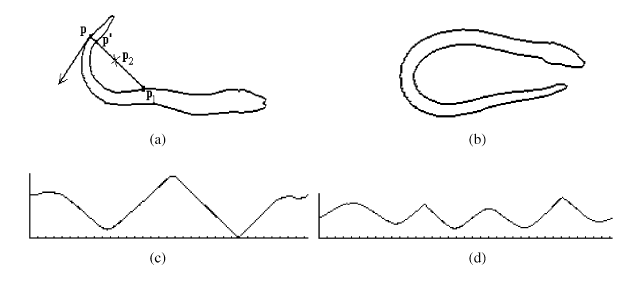In general, a shape signature u(t) is any 1D function representing 2D areas or boundaries, it usually uniquely describes a shape. A shape signature usually captures the perceptual feature of the shape. In the following, we assume the shape boundary coordinates (x(t), y(t)), t=0, 1,., N-1,have been extracted in the preprocessing stage, t usually means arclength. In our implementation, the shape boundary points are extracted through a preprocessing module which consists of a denoising procedure and a 8-connectivity contour tracing procedure . For notation convenience,different function names will be employed to denote different shape signatures.
Centroid distance. The centroid distance function is expressed by the distance of the boundary points to the centroid (xc, yc) of the shape

r(t) is also invariant to translation. Rotation causes r(t) circular shift, and scaling of shape only changes r(t) linearly.
ChordLength signature. r(t) is a convenient shape signature, but it has to use shape centroid as reference point.The use of centroid as reference point is not a serious
problem if the shape is a convex shape. For convex shape,the centroid is inside the shape, therefore, the structure ofthe shape is preserved by the acquired signature when theshape is under distortion. However, for non-convex shape,the centroid is often outside the shape, therefore, thestructure of the shape cannot be preserved by the acquired
signature when the shape is under distortion. For example,Fig. 2(c) and (d) are respectively the r(t) signatures of thetwo similar shapes in Fig. 2(a) and (b), the structures of the two shapes are not preserved by the acquired r(t) signatures.

In order to overcome the reference point problem of r(t),we propose a new shape signature, called chordlength signature. The chordlength function r*(t) is derived from
shape boundary without using any reference point. For each boundary point p, its r*(t) is the distance between p and another boundary point p0 such that pp0 is perpendicular to
the tangent vector at p (Fig. a). This definition can cause ambiguities when the line of pp0 passes through more than one boundary points. To solve this problem, another constraint is added by limiting pp0 within the shape. For example, in Fig. a, p1 is one of the candidates for p0, however, by checking the middle point p2 of pp1, p1 should
be eliminated because p2 is not within the shape. If p2 is still within the shape, the middle point of pp2 and the middle of p1p2 are checked by the second constraint. This process is repeated until a middle point is found to be outside the
shape. If after this recursive checking process, no outer
middle point is found, then p1=p0.






















 1561
1561

 被折叠的 条评论
为什么被折叠?
被折叠的 条评论
为什么被折叠?








